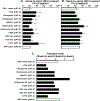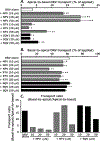P-glycoprotein mediates efflux transport of darunavir in human intestinal Caco-2 and ABCB1 gene-transfected renal LLC-PK1 cell lines
- PMID: 19721237
- PMCID: PMC6526530
- DOI: 10.1248/bpb.32.1588
P-glycoprotein mediates efflux transport of darunavir in human intestinal Caco-2 and ABCB1 gene-transfected renal LLC-PK1 cell lines
Abstract
Darunavir (DRV) is a nonpeptidic protease inhibitor (PI) approved for the treatment of human immunodeficiency virus (HIV) infection. DRV displays potent activity against HIV strains resistant to other available PIs. Coadministration with ritonavir (RTV) improves the oral bioavailability of DRV. Inhibition of cytochrome P450 by RTV has been proposed as a mechanism for enhanced DRV bioavailability. However, interaction of these drugs with intestinal transporters has not been elucidated. This study was performed to explore the involvement of P-glycoprotein in transcellular DRV transport in monolayers of human intestinal Caco-2 and in ABCB1 multidrug resistance 1, (MDR1) gene-transfected renal LLC-PK1 (L-MDR1) cell lines. Transepithelial transport of DRV in Caco-2 cell monolayers was 2-fold greater in the basal-to-apical direction compared to that in the opposite direction. RTV had a significant inhibitory effect on the efflux transport of DRV in Caco-2 cells. The apical-to-basal DRV transport was enhanced by P-glycoprotein inhibitors, cyclosporin A and verapamil, as well as multidrug resistance-related protein (MRP/ABCC) inhibitors, probenecid and MK571. Using the L-MDR1 cell line, basal-to-apical DRV transport was much greater than in the opposite direction. Furthermore, cyclosporin A markedly inhibited the basal-to-apical DRV transport. RTV significantly increased the apical-to-basal transport of DRV in L-MDR1 cells, but reduced transport in the opposite direction. DRV inhibited P-glycoprotein-mediated efflux of calcein-acetoxymethyl ester in L-MDR1 cells with the inhibitory potency of 121 microM. These findings suggest that DRV is a substrate of P-glycoprotein and MRP, most likely MRP2. RTV appeared to inhibit P-glycoprotein, thereby enhancing the absorptive transport of DRV.
Figures





Similar articles
-
Role of P-glycoprotein in the efflux of raltegravir from human intestinal cells and CD4+ T-cells as an interaction target for anti-HIV agents.Biochem Biophys Res Commun. 2013 Sep 20;439(2):221-7. doi: 10.1016/j.bbrc.2013.08.054. Epub 2013 Aug 24. Biochem Biophys Res Commun. 2013. PMID: 23981805
-
Assessment of active transport of HIV protease inhibitors in various cell lines and the in vitro blood--brain barrier.AIDS. 2001 Mar 9;15(4):483-91. doi: 10.1097/00002030-200103090-00007. AIDS. 2001. PMID: 11242145
-
Differences in the expression of endogenous efflux transporters in MDR1-transfected versus wildtype cell lines affect P-glycoprotein mediated drug transport.Br J Pharmacol. 2010 Jul;160(6):1453-63. doi: 10.1111/j.1476-5381.2010.00801.x. Br J Pharmacol. 2010. PMID: 20590635 Free PMC article.
-
Mechanism of multidrug recognition by MDR1/ABCB1.Cancer Sci. 2007 Sep;98(9):1303-10. doi: 10.1111/j.1349-7006.2007.00538.x. Epub 2007 Jun 30. Cancer Sci. 2007. PMID: 17608770 Free PMC article. Review.
-
The influence of MDR1 polymorphisms on P-glycoprotein expression and function in humans.Adv Drug Deliv Rev. 2002 Nov 18;54(10):1295-310. doi: 10.1016/s0169-409x(02)00064-9. Adv Drug Deliv Rev. 2002. PMID: 12406646 Review.
Cited by
-
A Unique In Vitro Assay to Investigate ABCB4 Transport Function.Int J Mol Sci. 2023 Feb 24;24(5):4459. doi: 10.3390/ijms24054459. Int J Mol Sci. 2023. PMID: 36901890 Free PMC article.
-
Evaluation of the Potency of Anti-HIV and Anti-HCV Drugs to Inhibit P-Glycoprotein Mediated Efflux of Digoxin in Caco-2 Cell Line and Human Precision-Cut Intestinal Slices.Pharmaceuticals (Basel). 2022 Feb 18;15(2):242. doi: 10.3390/ph15020242. Pharmaceuticals (Basel). 2022. PMID: 35215354 Free PMC article.
-
Potential Tools for Eradicating HIV Reservoirs in the Brain: Development of Trojan Horse Prodrugs for the Inhibition of P-Glycoprotein with Anti-HIV-1 Activity.J Med Chem. 2020 Mar 12;63(5):2131-2138. doi: 10.1021/acs.jmedchem.9b00779. Epub 2019 Sep 20. J Med Chem. 2020. PMID: 31505928 Free PMC article.
-
Role of P-Glycoprotein Inhibitors in the Bioavailability Enhancement of Solid Dispersion of Darunavir.Biomed Res Int. 2017;2017:8274927. doi: 10.1155/2017/8274927. Epub 2017 Oct 31. Biomed Res Int. 2017. PMID: 29226149 Free PMC article.
-
Effect of four ABCB1 genetic polymorphisms on the accumulation of darunavir in HEK293 recombinant cell lines.Sci Rep. 2021 Apr 26;11(1):9000. doi: 10.1038/s41598-021-88365-7. Sci Rep. 2021. PMID: 33903659 Free PMC article.
References
-
- Bartlett JA, Fath MJ, Demasi R, Hermes A, Quinn J, Mondou E, Rousseau F, AIDS, 20, 2051–2064, (2006). - PubMed
-
- Piacenti FJ, Pharmacotherapy, 26, 1111–1133 (2006). - PubMed
-
- Belmonte L, Baré P, de Bracco MM, Ruibal-Ares BH, Curr. Med. Chem, 10, 303–312 (2003). - PubMed
-
- Kozal MJ, Hullsiek KH, Macarthur RD, Berg-Wolf M, Peng G, Xiang Y, Baxter JD, Uy J, Telzak EE, Novak RM, HIV Clin. Trials, 8, 357–370 (2007). - PubMed
-
- Siliciano JD, Siliciano RF, J. Antimicrob. Chemother, 54, 6–9 (2004). - PubMed
Publication types
MeSH terms
Substances
Grants and funding
LinkOut - more resources
Full Text Sources
Research Materials
Miscellaneous

